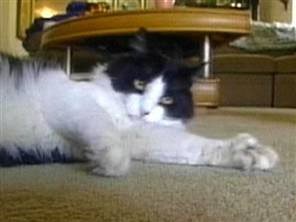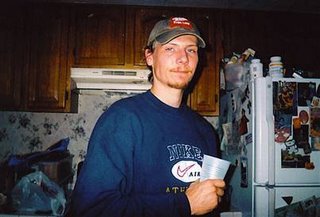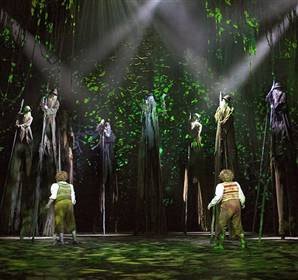Why Privacy Won't Matter
Google, Yahoo and Microsoft desperately want to know every last thing about what you do, say and buy. Here's how they'll do it—and why we'll let them.By David H. Freedman
Newsweek International
 Illustration by Alex Nabaum for Newsweek
Illustration by Alex Nabaum for NewsweekApril 3, 2006 issue - A friend takes your picture with her cell phone, and puts the phone back in her purse. But the gadget isn't dormant. It gets to work figuring out who you are, and sends that information, along with your precise location, to an organization that adds the data to a file it keeps on where you go and who you hang out with, as well as other things. The organization then charges money to help others who want to reach you, and even notifies certain people nearby of your presence.
Who is this shadowy organization? It's Google—as well as Yahoo, Microsoft and AOL, among others. None of these companies are tracking you using cell-phone photos today, of course; that capability is still at least a few years off. But they are following you in other ways, and profiting from doing so. And they're gearing up to keep a much closer eye on all of us, so that within five years these and other firms will routinely track our movements, friends, interests, purchases and correspondence—then make money by helping marketers take advantage of the information.
These companies' brash plans are pushing us toward a thorny choice that will determine the future of computing. Google and other Web-oriented, information-service giants are determined to build a breathtaking array of services based on your personal information, and they're betting you'll be willing to share it with them in order for you to reap the benefits. But if we cooperate and let them in on the details of our lives, we'll lose much of our privacy, and possibly a lot more.
When the files on us are so detailed that it becomes easy to document our political beliefs, love lives, embarrassing habits and petty crimes, we risk becoming routinely persecuted for them—or, even worse, afraid to engage in any behavior that others might find controversial. "What's going to be taking place over the next 10 years in the privacy space will have profound implications for how we relate to each other socially, economically and politically," says Jerry Kang, a UCLA law professor who studies the impact of technology on privacy. "We shouldn't be too quick to turn personal data over to market forces."
A privacy backlash, however, would stifle these potentially revolutionary services before they get off the ground—and leave the computer industry's biggest plan for growth in tatters. That may be just what some people want. The U.S. Congress is considering four bills that would make it illegal for companies to collect and share information online or through cell phones about people without clearer warning and permission. These sorts of restrictions are already in effect throughout much of Europe, thanks in part to European Union directives on privacy and electronic communications passed in 2002 and 2003.
These efforts seem doomed to fail eventually: a new generation of consumers, now teenagers, are growing up without any qualms about giving away every shred of information about themselves online. The good news is that there's no reason to choose between technology and privacy. New technologies are emerging that can doctor our data so that companies know just enough about us to ply us with customized services, while preventing them from getting a clear picture of our private lives. The question is again one of trust: in this case, whether people will come to trust the companies that are trying to build these new technologies.
What Google and its competitors plan to dangle before us is in essence the ultimate search engine: one that finds information based not just on what you type in, but on what you really want, and that feeds it to you wherever and whenever it's most useful. Keyword searching is a blunt instrument when you want to find the cheapest way to send flowers to a friend in Cleveland, to know which of the movies opening near you next week will be your kind of flick, to find people in your town who share your interests in boating and beekeeping. Yahoo's research head Prabhakar Raghavan says the solution is what he calls the "sentient network." "The network magically figures out what you're looking for and provides it at the right time, anywhere," he says—on the PC at your desk, the home entertainment system in your living room, a cell phone in a store. Marissa Mayer, Google's vice president of search products and user experience, waxes on about simply speaking out loud in plain English to your car to have it connect you to the nearest two-star French restaurant, or to your TV to have it download any episodes of "Survivor" you missed. Sometimes you won't even have to ask. "Whatever computer I have with me will just listen to what I'm saying, and take interesting actions on my behalf online," she says.
This proposed new world of ultrapersonalized information on the go is being driven by a new array of computing and tracking technologies that have already hit the streets, or will in the next few years. Cell phones are getting powerful computer chips, and most are already capable of pinpointing your location. When you take a picture of someone with your phone, notes David Stork, chief scientist at electronics manufacturer Ricoh's California Research Center, the phone may soon be able to figure out who it is based on what it knows about your location and your contact list. Phones already are serving as wireless credit cards in Asia and parts of Europe. That would allow tracking your purchases, so that the network might learn to notify you when a nearby restaurant is serving a favorite special, or when a store next door is running a sale on jeans.
Want to give being tracked a rest? You could turn your cell phone off, but that won't stop smart video cameras from recognizing you. Some 25 million surveillance cameras are already in place in stores and public spaces in the United States alone, and new ones are coming online at the rate of 2 million a year. In cities like London, it's difficult to walk down the street without being photographed from several different angles. Right now recognizing someone requires a human monitor, but that won't be true in five-or-so years. "The network will know you about as well as a good friend does," says Michael Gold, a senior researcher at SRI Consulting Business Intelligence in Menlo Park, Calif.
Ubiquitous wireless networks, along with cheap radio chips and plastic video displays, will turn products on shelves and in your home into "smart objects." Princeton electrical-engineering professor Wayne Wolf, who is developing a smart video camera that can help stores track customers, predicts a supermarket cereal aisle that will recognize you and prompt a box of your favorite cereal to light up with a reminder that it's been two weeks since you last bought one—time to re-up. "If you have the information on where someone is, and the cereal box is linked to the network, it's easy to customize the message displayed on the box," explains Wolf. Within five years most of us will routinely get highly customized information as we make our way down the street—an alert on a cell phone that your boss or a college friend is in town, or an invitation via the car stereo from a store that you're passing to drop in and pick up a favorite product at a sharp discount. Early versions of some of these services are already running.
The network may know you like a friend, but it will do something that your friend wouldn't: feed you advertisements throughout the day, wherever you are, based on your personal information. It'll have to, because that's the only way Google, Yahoo and others will be able to make money, given that we've all become spoiled by free Web services. "Charging a fee for an online service is a good way to lose 90 percent of your customers," says Steve Jurvetson, managing director of Draper Fisher Jurvetson, a high-tech venture-capital firm in Menlo Park. "But human attention is always monetizable."
That is, Google and its rivals can sell the opportunity to put an ad in front of you that is tightly keyed to your detailed profile, and to what you're doing at that moment. Did you watch a show about solar power on the Discovery Channel? Making a lot of trips to the auto-repair shop? Sounds like you're a candidate for an ad for a hybrid car, to be routed to your cell phone or car when you're within three blocks of a dealer. Google's big innovation wasn't making a better search engine—it was recognizing that tying information needs to ads on the fly was the missing link in the computer revolution.
Tailored, on-the-go information services are likely to prove irresistible to consumers—which is why all the big Web players are frantically retooling their business plans to provide them. Google has an early lead, but Yahoo, Microsoft and Time Warner's AOL are rushing to put their own spins on the trend. In fact, almost every corner of the computer and communications industries—indeed, much of the business world—is giving serious thought to how to get in on the action. No wonder: Search-engine-driven advertising is already a $10 billion worldwide market, expected to hit $30 billion in four years—and that's without a new range of customized services. The potential take is no less than the $400 billion spent worldwide on advertising each year.
To pull off these sponsored services, Google, Yahoo and others need to know who you are; where you are; what you buy, watch and read; who you spend time with, and even what you say to your friends. No business wants to be caught spying on its customers, of course; these companies plan to nudge and seduce us, literally bit by bit, into agreeing to let them gather the information advertisers need for tailored pitches. Forty-one percent of online users already visit Google at least once a week to run a search, but keywords are a limited source of ad customization, notes analyst Charlene Li at Forrester Research. "Google is desperate to sign people up to do more personal things," she says.
Spearheading that drive is the company's Gmail service, which requires users to agree to let Google key ads to the contents of their e-mail notes, and Google Desktop, which gathers information on all the files on a user's computer. Want to sign up for Gmail? No problem—all you have to do is give Google your cell-phone number, even though the service has little to do with cell phones yet. "Right now we can watch a lot more activity on someone's PC," says Google's Mayer. "But it's easily possible over the next few years that a lot of that will move to the cell phone." She adds that the company plans to put as much of its computing resources into serving targeted ads as it does into searching.
Yahoo has the same idea, but with more emphasis on targeting users according to their relationships with other users. "Our research has to get more deeply embroiled with social networks," says Yahoo's Raghavan. "Finding out your likes and dislikes is just the beginning of the proposition." One possibility is hitting up people with ads based on how their friends and colleagues reacted to the same ad, he notes. And where Google vows to continue to clearly separate and label its sponsored content, Yahoo is looking into ways to blend them. One experimental search engine on Yahoo's site allows you to adjust the results to make them more or less oriented toward shopping, and sponsored results could become a part of that mix, says Raghavan. "Wouldn't it be nice if the network knew you liked to visit warm places, and put together a $3,000 package to Cancún?" he says.
Microsoft has no intention of being left out. The firm is slowly shifting its emphasis away from PC-based software like Windows and Office to its new, Web-based Live services that work partly on your computer and partly on the network. "We're offering a deeper value exchange now," says Adam Sohn, director of global consumer marketing for Microsoft's MSN division. "You give us access to more personal information about you and your activities, and we can show you ads that make sense to you." AOL could be a big player, too, thanks largely to its instant-messaging service, which already includes advertising "robots," or software that can provide sponsored information as messages. Cell-phone firms may offer sponsored tracking services, car companies are rolling out networks like GM's OnStar, and any store or building could put up a wireless network that provides targeted advertisements in exchange for access.
Should we put up with it? Maybe, says Joseph Moran, a privacy lawyer at Duane Morris. "There may be an acceptable balance between decreasing privacy standards and the benefits that the services give us, as long as there's an informed user base," he says. If trusted companies like Google or Yahoo can get us to dip our toes into these services, as many of us already have, we may well find them useful enough to lower our resistance to turning over more and more of our data. And even if most people's concerns about sharing too much don't quickly dissipate, time is on the side of these services, thanks to privacy-challenged teenagers. "Young people think of the Internet as a fact of life," says Yahoo's Raghavan. "They're more open to targeting."
The result would be an erosion of privacy very different from the ones privacy advocates have long warned about—coming not at the hand of a big-brother government, nor of stalkers, hackers, telemarketers, spammers or abusive employers, but rather of companies bribing us with services. Once the story of your day-to-day life is on file at Google and other companies, you'll simply have to take it on faith that they won't let it get into the hands of law-enforcement agencies, the IRS, your spouse, your boss, extortionists, predators and any-one else who might be working against your interests.
And no matter how trustworthy these companies turn out to be, they might not be able to stop subpoenas and hackers from lifting the data anyway—a lesson driven home last month when a U.S. federal judge ruled that Google must partially comply with a Department of Justice demand for some of the company's search data. Even if your information isn't blatantly misused, you could find yourself thinking twice before doing anything that someone else might find objectionable, or even standing up for your beliefs. "Each generation might become more comfortable with a lack of privacy, so that we end up in a society where anyone can find out anything about you," warns UCLA's Kang. "When that happens, you have to wonder what happens to dissent, even in a free society."
For those who object to the notion of being tracked, there may be some protection short of "going off the grid"—that is, giving up all computer services. Companies could promise to track information about you without associating it with your name or identity, much as Web-site "cookies" do today. Or they could offer to periodically destroy all the data they've kept on you. And thanks to some promising new technologies now in labs, we may be able to have our cake and eat it, too. For example, researchers are working on techniques that "distort" personal data just enough to prevent reliable identification, by randomly altering the data. "You'll lose some degree of personalized service, but you'll have more control over your privacy," says Ramnath Chellappa, an information-technology researcher at Emory University's business school who is working on the technology. And Carnegie Mellon professor Latanya Sweeney has developed a way to modify video systems to prevent people's being recognized by morphing their facial features. "It de-identifies people, guaranteed," she says. Yet another approach: the network could maintain an "information shield" that watches for and blocks the transmission of any of your personal data that you've declared off-limits.
Perhaps in the end governments need to step in, if for no other reason than to require that Google and other information services take greater pains to make sure users know exactly what they're getting into. Right now, users rotely click "yes" to numbingly verbose and universally ignored agreements on Web pages. But more of us might think twice if, for example, the government required companies to have us click on a single, bold-faced line in the middle of an otherwise blank page that read, "I agree to let Google collect, store and analyze information about everything I do on the network and use it to help other companies target me for advertisements."
Some of these points will be worked out in the courts, when angry users sue companies for being too loose with their personal data. It might be someone whose cigar-buying habits are shared with the insurance company that issued him a nonsmoker's policy; or the churchgoer who's sitting next to a deacon when her cell phone chirps out a $3-off offer on a bottle of Scotch; or the Boy Scout leader who gets kicked out when he ends up on a gay-rights mailing list after a camera noticed he was standing near the gay-literature section in a bookstore. "One way to see where technology is heading is to see where the lawsuits are heading," says Stork. Perhaps lawyers will end up paying Google to flash their ads in front of anyone whose privacy has been violated. Now that's justice, 21st-century style.











